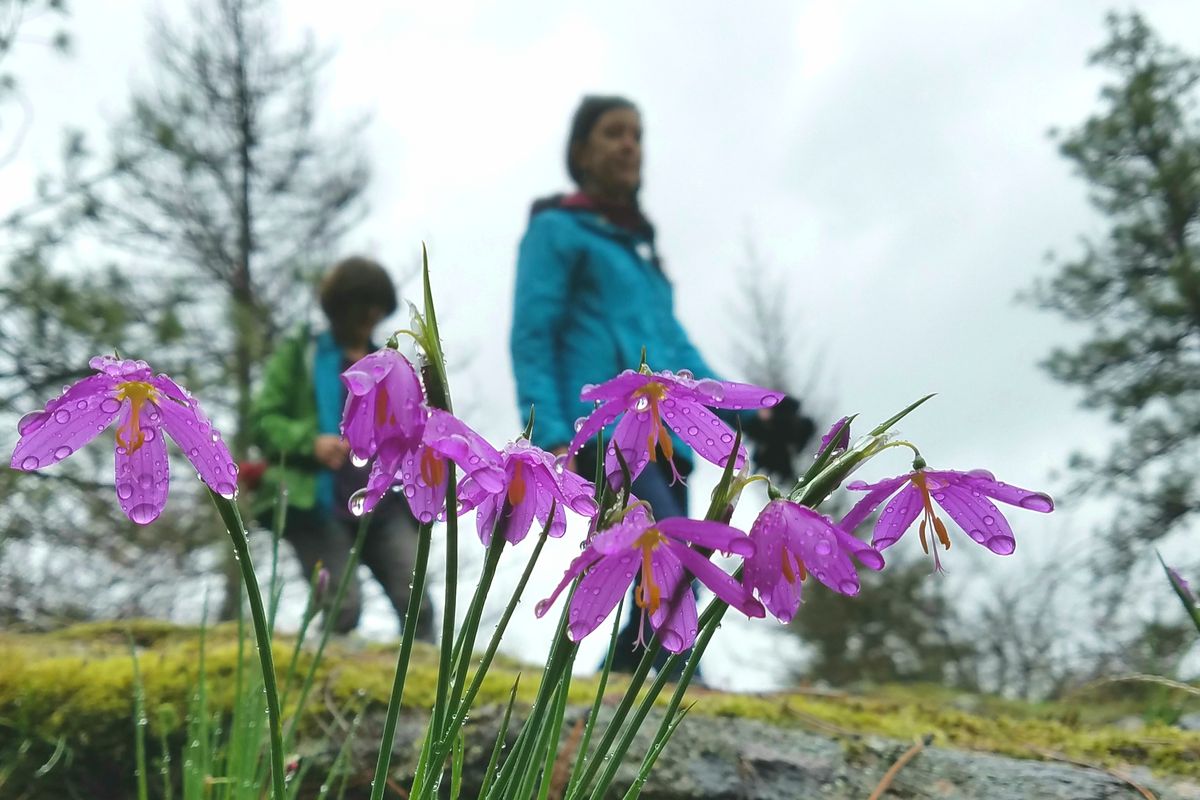The good pick: Challenging kids to appreciate nature, one flower at a time

The golden rule of wildflower etiquette is the three words kids don’t want to hear: “Look, don’t touch.”
It seems reasonable to point out that picking an attractive flower that catches your eye eliminates the possibility of anyone else enjoying the same eye-catching pleasure.
Unfortunately, most kids, and some adults, are a little weak in the realm of abstract consideration when a brilliant patch of arrowleaf balsamroot is attracting their hands like a magnet.
Picking wildflowers also can eliminate seeds and reduce their opportunity to reproduce at that location.
But kids don’t care much about reproduction beyond the mystery of how M&Ms keep showing up on rocks down the trail, in the direction that Mom and Dad want to go.
Thirty years ago, I created a game with my two young daughters aimed at preventing them from being a force against nature.
When we hiked, they could not resist picking a bluebell here and a grass widow there. As the fragile flowers wilted – even in watered vases, most wildflowers droop quickly – the kids would mindlessly drop them on the ground and pick fresh ones.
Patches of asters could easily become disasters.
Considering that the Landers family did a LOT of hiking and camping, I felt obligated to come up with a fun family plan for native plant conservation.
To my surprise, the kids quickly embraced the challenge. During certain hikes or campouts, each of them would be allowed to select and pick a wildflower, but no more than one specimen of each kind, and only AFTER they’d learned its name.
In a daypack (along with lots of snacks and water) I carried a wildflower field guide and an old hardcover book to hold collected flowers, plus a strap to keep it closed while moving.
At young ages, the kids weren’t always interested in the field guide, so we didn’t force it on them.
I would help them put each specimen between the bookmarked pages throughout the book. Back at home, we would carefully transfer and spread the flowers, stems and leaves onto the pages of a telephone book or between sheets of blotter paper in flower presses I made from plywood and four carriage bolts.
We’d apply some weight on top of the book or twist the wingnuts on the press and leave the flowers alone for at least two weeks.
At some appropriate time with no distractions, we’d go to the bookmarks in the book or let our fingers do the walking through the Yellow Pages for a natural history lesson.
Opening the pages to see how the flowers pressed always thrilled the girls, and me, too. We’d recall the names and make plans for labeling and displaying the flowers in various ways such as in notebooks, artwork, posters and cards.
Three decades later, the challenge still works. I verified this on recent spring break nature outings with our granddaughters – Lucy, 3, and Livia, 5.
Our family of budding naturalists – grandparents, parents and kids – bushwacked off-trail to an isolated area of ponderosa pine forest. The goal was to build on the countless outdoor experiences already introduced to the girls by their dad and mom (my favorite oldest daughter).
We let the two girls wander, seek and ultimately collect three early-spring specimens – buttercup, yellowbell and grass widow.
The next day we went out again. Indeed, the girls could identify the three species by name and weren’t even tempted to pick them.
Livia had donned a tutu to be as pretty as a flower and brought her sketch book for drawing plant portraits.
Lucy enjoyed posing for photos next to her favorite flowers in their native habitat. Smartphone cameras offered instant gratification.
This game never has to end. New flowers can be introduced into summer – indeed, annually as the kids grow up – to keep generating interest. Gradually over the seasons and the years, new topics can be approached.
For instance, the dazzling yellow-centered white blooms of oxeye daisies along a forest road could trigger discussion about invasive weeds versus native plants.
Seeing a bee, butterfly or other insect on a flower is the perfect time to point out that taking plants from a field eliminates food and cover for pollinators and other essential bugs.
The awesome discovery of one or two delicate calypso orchids could conjure up a lesson on abundance.
“Perhaps we shouldn’t collect even just one of those,” you might say. “They’re so rare and special, let’s just get on our tummies, study them closely, appreciate them, and take a picture.”
It works.
Be aware of rules that might prohibit the taking of even a single flower from designated conservancies such as the Dishman Hills Natural Area and national parks.
(Indeed, our family once was treated to a serious but informative lecture on a trail in Hawaii Volcanoes National Park when our youngest daughter disobeyed the posted sign and tried to get out to the parking lot with a chunk of lava rock in her pocket.)
The real beauty of a wildflower walk is that it’s always much more than that.
During our recent spring break outings, we marveled at the different calls of a raven and noted how bark flaking off a ponderosa pine looked like jigsaw puzzle pieces.
Livia flexed her athletic skills playing pinecone soccer on the trail. Not to be outdone, 37-month-old Lucy learned how to go No. 2 in the woods.
It won’t be long before they’ll come across a carcass for a lesson on predators and prey. Maybe they’ll return to camp to roast marshmallows and talk about good fires and bad fires. Certainly, they’ll learn how to deal with mosquitoes, yellowjackets and ticks, and how to use bear spray.
As adults, they can become outdoors enthusiasts and conservationists, or not. But at least a seed from that first pressed flower will have been planted.